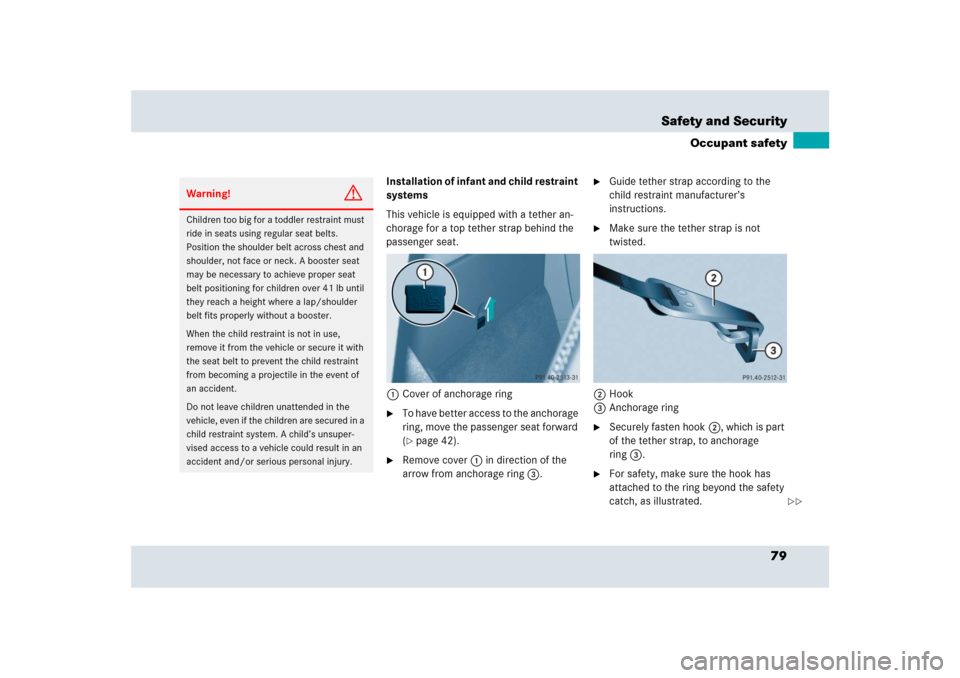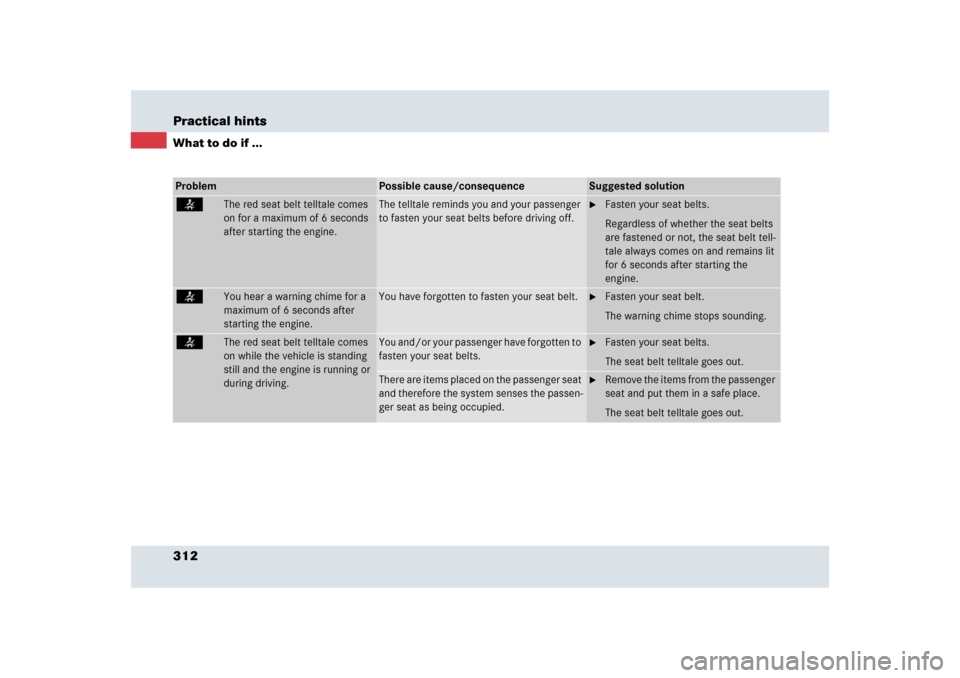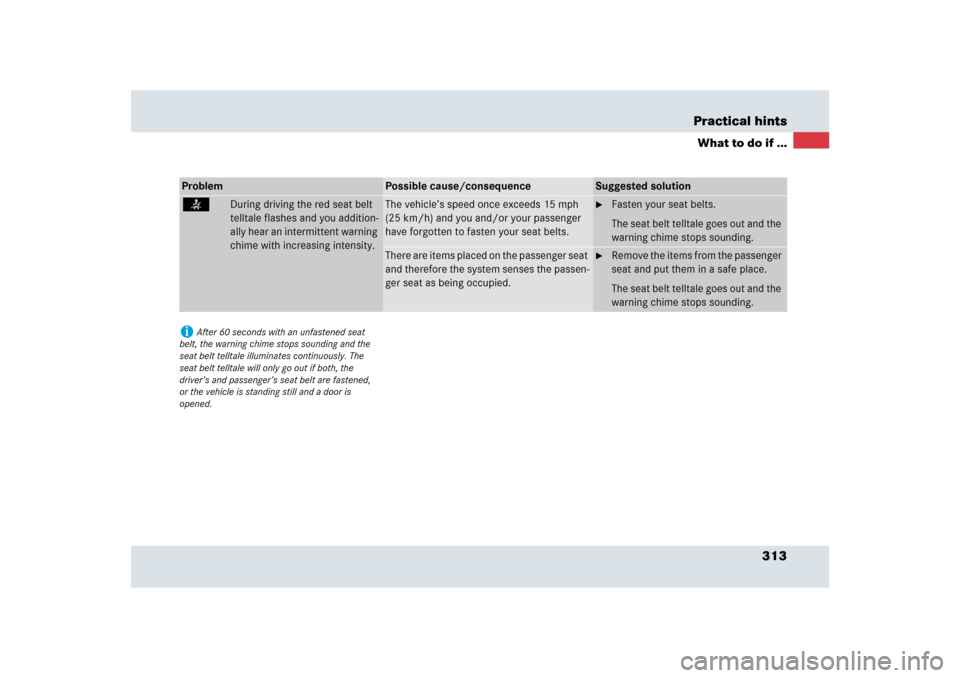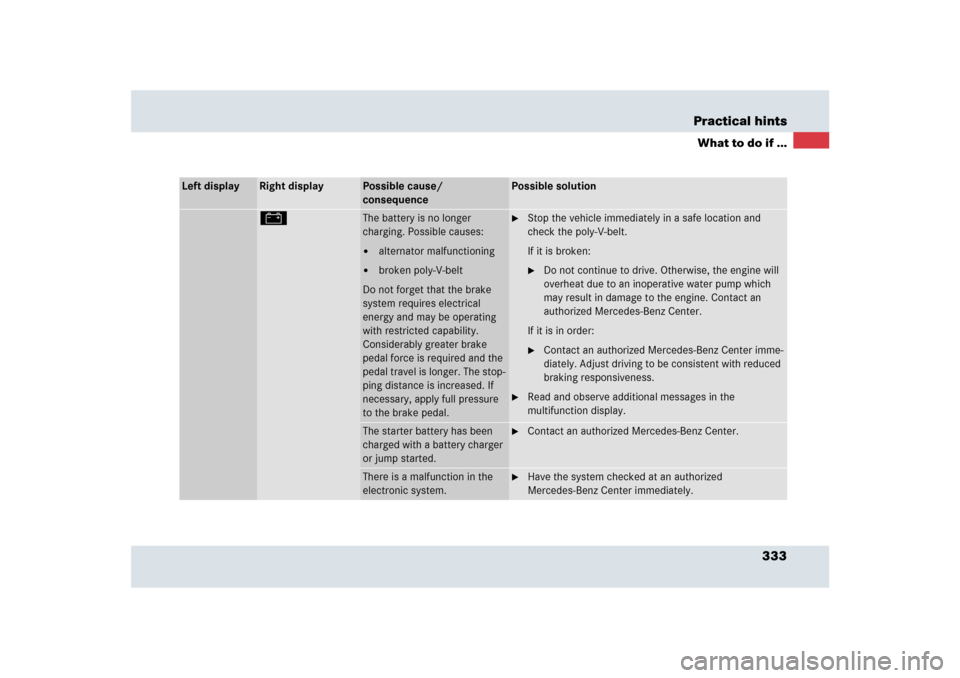Page 79 of 426

79 Safety and Security
Occupant safety
Installation of infant and child restraint
systems
This vehicle is equipped with a tether an-
chorage for a top tether strap behind the
passenger seat.
1Cover of anchorage ring�
To have better access to the anchorage
ring, move the passenger seat forward
(�page 42).
�
Remove cover1 in direction of the
arrow from anchorage ring3.
�
Guide tether strap according to the
child restraint manufacturer’s
instructions.
�
Make sure the tether strap is not
twisted.
2Hook
3Anchorage ring
�
Securely fasten hook2, which is part
of the tether strap, to anchorage
ring3.
�
For safety, make sure the hook has
attached to the ring beyond the safety
catch, as illustrated.
Warning!
G
Children too big for a toddler restraint must
ride in seats using regular seat belts.
Position the shoulder belt across chest and
shoulder, not face or neck. A booster seat
may be necessary to achieve proper seat
belt positioning for children over 41 lb until
they reach a height where a lap/shoulder
belt fits properly without a booster.
When the child restraint is not in use,
remove it from the vehicle or secure it with
the seat belt to prevent the child restraint
from becoming a projectile in the event of
an accident.
Do not leave children unattended in the
vehicle, even if the children are secured in a
child restraint system. A child’s unsuper-
vised access to a vehicle could result in an
accident and/or serious personal injury.
��
Page 80 of 426
80 Safety and SecurityOccupant safety�
Move the passenger seat as far as
possible rearward.
Once the top tether anchorage hook is
attached, the child restraint itself can be
secured.
�
Properly secure the child restraint us-
ing the passenger seat lap/shoulder
belt (
�page 76) and tether anchorage
for top tether strap, fully in accordance
with the child restraint manufacturer’s
instructions.
�
Tighten the top tether strap according
to the child restraint manufacturer’s
instructions.
�
Reinstall cover1 after removing the
tether strap.
��
Page 277 of 426

277 Operation
Tires and wheels
Tire size designation, load and speed
rating
1Tire width
2Aspect ratio in %
3Radial tire code
4Rim diameter
5Tire load rating
6Tire speed ratingGeneral:
Depending on the design standards used,
the tire size molded into the sidewall may
have no letter or a letter preceding the tire
size designation.
No letter preceding the size designation
(as illustrated above): Passenger car tire
based on European design standards.
Letter “P” preceding the size designation:
Passenger car tire based on U.S. design
standards.
Letter “LT” preceding the size designation:
Light Truck tire based on U.S. design
standards.
Letter “T” preceding the size designation:
Temporary spare tires which are high
pressure compact spares designed for
temporary emergency use only.
Tire width
The tire width1 (
�page 277) indicates
the nominal tire width in mm. Aspect ratio
The aspect ratio2 (
�page 277) is the
dimensional relationship between tire
section height and section width and is
expressed in percentage. The aspect ratio
is arrived at by dividing section height by
section width.
Tire code
The tire code3 (
�page 277) indicates
the tire construction type. The “R” stands
for radial tire type. Letter “D” means diag-
onal or bias ply construction; letter “B”
means belted-bias ply construction.
At the tire manufacturer’s option, any tire
with a speed capability above 149 mph
(240 km/h) can include a “ZR” in the size
designation (for example: 245/40 ZR 18).
For additional information, see “Tire speed
rating” (
�page 279).
i
For illustration purposes only. Actual data
on tires is specific to each vehicle and may vary
from data shown in above illustration.
Page 312 of 426

312 Practical hintsWhat to do if ...Problem
Possible cause/consequence
Suggested solution
<
The red seat belt telltale comes
on for a maximum of 6 seconds
after starting the engine.
The telltale reminds you and your passenger
to fasten your seat belts before driving off.
�
Fasten your seat belts.
Regardless of whether the seat belts
are fastened or not, the seat belt tell-
tale always comes on and remains lit
for 6 seconds after starting the
engine.
<
You hear a warning chime for a
maximum of 6 seconds after
starting the engine.
You have forgotten to fasten your seat belt.
�
Fasten your seat belt.
The warning chime stops sounding.
<
The red seat belt telltale comes
on while the vehicle is standing
still and the engine is running or
during driving.
You and/or your passenger have forgotten to
fasten your seat belts.
�
Fasten your seat belts.
The seat belt telltale goes out.
There are items placed on the passenger seat
and therefore the system senses the passen-
ger seat as being occupied.
�
Remove the items from the passenger
seat and put them in a safe place.
The seat belt telltale goes out.
Page 313 of 426

313 Practical hints
What to do if ...
Problem
Possible cause/consequence
Suggested solution
<
During driving the red seat belt
telltale flashes and you addition-
ally hear an intermittent warning
chime with increasing intensity.
The vehicle’s speed once exceeds 15 mph
(25 km/h) and you and/or your passenger
have forgotten to fasten your seat belts.
�
Fasten your seat belts.
The seat belt telltale goes out and the
warning chime stops sounding.
There are items placed on the passenger seat
and therefore the system senses the passen-
ger seat as being occupied.
�
Remove the items from the passenger
seat and put them in a safe place.
The seat belt telltale goes out and the
warning chime stops sounding.
i
After 60 seconds with an unfastened seat
belt, the warning chime stops sounding and the
seat belt telltale illuminates continuously. The
seat belt telltale will only go out if both, the
driver’s and passenger’s seat belt are fastened,
or the vehicle is standing still and a door is
opened.
Page 333 of 426

333 Practical hints
What to do if ...
Left display
Right display
Possible cause/
consequence
Possible solution
#
The battery is no longer
charging. Possible causes:�
alternator malfunctioning
�
broken poly-V-belt
Do not forget that the brake
system requires electrical
energy and may be operating
with restricted capability.
Considerably greater brake
pedal force is required and the
pedal travel is longer. The stop-
ping distance is increased. If
necessary, apply full pressure
to the brake pedal.
�
Stop the vehicle immediately in a safe location and
check the poly-V-belt.
If it is broken:�
Do not continue to drive. Otherwise, the engine will
overheat due to an inoperative water pump which
may result in damage to the engine. Contact an
authorized Mercedes-Benz Center.
If it is in order:
�
Contact an authorized Mercedes-Benz Center imme-
diately. Adjust driving to be consistent with reduced
braking responsiveness.
�
Read and observe additional messages in the
multifunction display.
The starter battery has been
charged with a battery charger
or jump started.
�
Contact an authorized Mercedes-Benz Center.
There is a malfunction in the
electronic system.
�
Have the system checked at an authorized
Mercedes-Benz Center immediately.
Page 341 of 426
341 Practical hints
What to do if ...
Left display
Right display
Possible cause/
consequence
Possible solution
•
Coolant
Stop car,
switch engine off.
The coolant is too hot.
Among other possible causes,
the poly-V-belt could be
broken.
�
Stop the vehicle in a safe location or as soon as it is safe
to do so.
�
Turn off the engine.
�
Check the poly-V-belt.
If it is broken:
�
Do not continue to drive. Otherwise, the engine will over-
heat due to an inoperative water pump which may result
in damage to the engine. Contact an authorized
Mercedes-Benz Center.
If it is intact:
�
Wait for the message to disappear before restarting the
engine.
Doing otherwise could result in serious engine damage
that is not covered by the Mercedes-Benz Limited War-
ranty.
(Continued on next page)
Page 353 of 426
353 Practical hints
What to do if ...
Left display
Right display
Possible cause/
consequence
Possible solution
<
Driver
Fasten Seat Belt
You have forgotten to fasten
your seat belt.
�
Fasten your seat belt.
Passenger
Fasten Seat Belt
Your passenger has forgotten
to fasten seat belt.
�
Fasten your seat belt.
O
You are driving with the hood
open.
�
Stop your vehicle as soon as it is safe to do so.
�
Close the hood (
�page 250).
Failure to follow these instructions increases the risk of an
accident.
2
You are attempting to drive
with one or more doors open.
�
Close the doors.
¨
This message will appear
whenever the trunk lid is open.
�
Close the trunk lid (
�page 103).
?
You are driving with the hood
and the trunk lid open.
�
Stop your vehicle as soon as it is safe to do so.
�
Close the hood (
�page 250) and the trunk lid
(
�page 103).
Failure to follow these instructions increases the risk of an
accident.